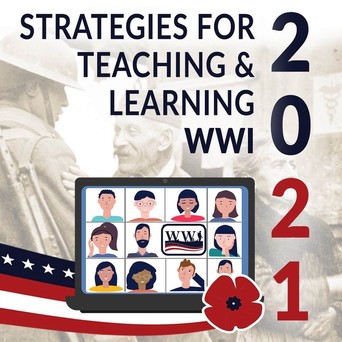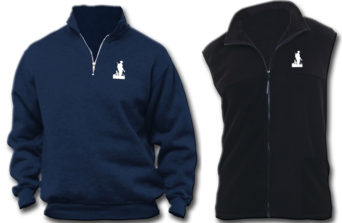Honoring America’s WWI servicemen and women "in a noble and timeless medium fitting to their service.”
January 19, 2021 was a significant day for the new National World War I Memorial in Washington, D.C. On this date, the 58-foot long, 38-figure Memorial centerpiece sculpture titled "A Soldier's Journey" reached a new milestone on its journey, as the sculpture's first elements were cast into bronze in a "First Pour." Click here to read more about, and watch a video of, the "First Pour" of the memorial sculpture at Pangolin Editions Foundry in the United Kingdom.
 New Education Webinar: Strategies and Tools for Teaching World War I in 2021
Calling All Educators… and Learners!
Please join our panel of World War I Educators on Friday, February 26, 2021, 1pm EST,: to learn some of the best practices now available for teaching World War I History in “classrooms, online, and hybrid," all of which will be a part of 2021.
We assembled a small group of educators from different areas and parts of the country to explore issues about teaching WWI from a real-world practical perspective:
- How teachers are adapting in teaching especially social studies, during the Pandemic.
- How do differing State standards affect teaching WWI
- Best practices, clever ideas, and limitations when teaching WWI
- Is teaching WWI through advanced placement (AP) European History & World History an option;
- How local WWI memorials can provide community engagement learning;
- Feedback from students about what works;
- and more.
Also on the agenda, we will introduce you to some of the education tools created by the Doughboy Foundation during and after the Centennial of WWI, including the USB thumb drive Website “How WWI Changed America;” specific WWI handouts for the classroom and to prompt learning and conversation; plus the innovative “WWI Memorial Virtual Explorer App” that provides an interactive augmented reality field trip to the new WWI Memorial in Washington, D.C.; and more.
Click here to register today to attend this FREE 2021 webinar for educators and learners about the challenges, opportunities and importance for teaching and learning about “The War That Changed the World”.
“WWI Education Webinar: Strategies and Tools for Teaching (and Learning) WWI in 2021” on Feb 26, 2021 1:00 PM EST
https://attendee.gotowebinar.com/register/1274955613107522318
After registering, you will receive a confirmation email containing information about joining the webinar.

In the Spring of 2011, the late James “Doc” Hall (left) visited the National Archives at College Park, Maryland, to search for World War ll KIA records of the 35th Infantry “Cacti” Regiment, in which he served in Vietnam. During his visit, Hall came across the Graves Registration records for WW l. The names he uncovered reflected the profound diversity of those who served in the Great War: immigrants, native Americans and boys from cities and farms were called to serve. Hall’s discovery of a KIA named "Isaac His Horse Is Fast" fascinated him. Hall contacted two fellow Vietnam combat veterans, Richard “Dick” Arnold and William “Bill” Henson, and proposed an ambitious project: photographing the WW l records and recording their critical data to a spreadsheet. As Henson recalls: "None of us fully understood what we were to experience." Click here to read the entire article about how three Vietnam veterans set off on a mission to remember those who preceded them in the nation's service a century ago.
|
Why Keep That? exhibition opens at National WWI Museum & Memorial

Collecting, cataloguing, conserving. The heart of a museum is its collection, but how do Museums make decisions and who gets to answer the question, “Why Keep That?”
Why Keep That?, the latest special exhibition at the National WWI Museum and Memorial, follows the journey of a collection item from the moment it is donated to the Museum, to the decision-making and archival process of our collections staff. To help illustrate, archival staff track the processing and digitization of a collection of 16 objects and share behind-the-scenes information about obtaining the artifacts, processing the items and storing and protecting them. Click here to read more about the exhibition, and how collections largely featuring ephemera – objects usually meant to be thrown away, like ticket stubs, advertisements and written scraps – are now preserved in a museum.
|

Luckily for industrial workers everywhere, Lt. Edward Wheatley Bullard of the U.S. Cavalry climbed out of the French trenches with an idea that would spark the industrial safety movement: the hard hat. Bullard, the son of a mining equipment supplier, was inspired by the metal helmets Doughboys wore to deflect the hail of bullets raining down on them courtesy of the Kaiser. When he returned home, he invented the first commercially available industrial hard hat, called the Hard Boiled hat. Prior to its invention and subsequent production in San Francisco, gold and copper miners in California and Nevada basically wore leather caps—which might not be all that good at stopping hail, let alone the rocks or tools potentially pouring down on them. Click here to learn more from Bullard's great granddaughter about how this now 100-year-old equipment was invented and how it has redefined protecting the workforce.
|

A man is only missing if he is forgotten.
Our Doughboy MIA this month is 1st LT Leonard Charles Aitken. Born in Reno, Nevada on 10 June 1897, Leonard Aitken grew up in California, where he joined the California National Guard at 18 years of age. When the trouble broke out with Mexico, he reported for duty in June, 1916 and served along the border with the hospital corps, attending elements of what would, a year later, become the 160th Infantry, 40th Division. Following America’s declaration of war on Germany, on 7 April 1917, Aitken reported to the Officers Training School at San Diego and upon graduation, shipped to France in August, 1918 as a 2nd lieutenant with the 158th Infantry, 40th Division. There, on 20 October 1918, he was sent as a replacement officer to the 372nd Infantry, 93rd Division, then holding a section of the line in the Alsace sector near Hill 607.
On 7 November, while leading his platoon on a night action, Aitkens and his men captured several prisoners but unknowingly walked into the line of fire of a German machine gun nest, which opened up on them, killing or capturing all but two enlisted men of the patrol and freeing the prisoners. Without hesitation Lieutenant Aitken immediately advanced against the position with the intent of eliminating it, but he was shot twice in the chest and killed in the endeavor. The end result was that they captured 1 officer (Aitkens) and 22 men; however the date of Aitkens’ death is given as 8 November 1918.
Following the Armistice, GRS officials went on the search for Aitkens’ remains, but had little luck. Their hardest clue was a report that German officers had buried Aitkens with full military honors “in the churchyard of the tiny hamlet of La Paive, some 40 miles east of Epinal, France.” There being no town by that name anywhere in that area, this was almost certainly actually the town of La Pariee which is indeed in the area of the action of 7 November. Nothing was ever found however and his remains continued to be unlocated in the years following the war. As investigations continued, in January 1924, GRS sent a letter to Aitkens’ father requesting a civilian dental chart, but also admitting in the letter that in all probability he was among the Unknown burials, though how this information was considered is not stated in his surviving file.
A final attempt at some kind of identification came in December 1926 when the case files of Aitkens and one other officer from the 372nd Infantry were checked against a set of Unknown remains at the Meuse-Argonne Cemetery morgue. It was a long shot, however, as the remains being checked came from a French cemetery in the Marne sector some 300 kilometers northwest of where both officers in question were at the time of their deaths. Not surprisingly, neither officer’s remains were a match and Aitkens’ case was officially closed in 1932 without resolution.
Can you spare just ten dollars? Give 'Ten For Them' to Doughboy MIA and help us make a full accounting of 1st LT Leonard Charles Aitken and all the 4,423 American service personnel still listed as missing in action from WW1. Make your tax deductible donation now, with our thanks. Visit www.ww1cc.org/mia today to make your donation, and sign up there to get more information on other ways that you may be able to help.
|
 You can wear your American pride and stay warm this winter with these two Made in the USA garments Inspired by the iconic image of a U.S. Doughboy. This poignant silhouette of a lone soldier in trench warfare serves as a reminder of those who sacrificed so much one century ago.
Sweatshirt features: Navy with white Doughboy embroidery. 80% cotton/20% polyester, 9.5 Oz. High quality heavy weight pre-shrunk fabric. Sweatshirt has ¼ zip pullover with cadet collar and silver metal zipper. Ribbed cuffs and waistband with spandex. Cover-seamed arm holes. Mens’ sizes available Small and Medium.
Vest features: Black with white Doughboy embroidery. 100% spun polyester, 12.5 Oz. Premium anti-piling fleece. Vest has full zip front with two side seam pockets. Mens’ sizes available S – 2XL.
Proceeds from the sale of these items will help to fund the building of the national World War One Memorial in Washington, D.C.
A Certificate of Authenticity as Official Merchandise of the United States World War One Centennial is included.
These and many other items are available as Official Merchandise of the United States World War One Centennial.
|